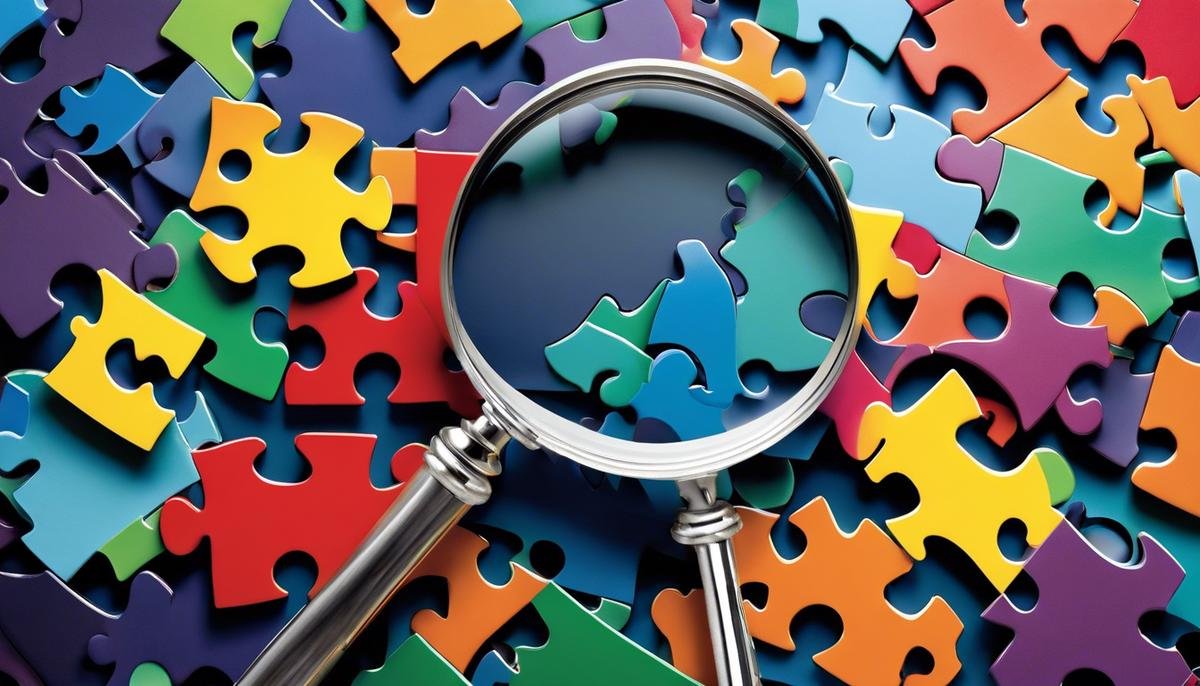
Autism Spectrum Disorder (ASD) presents a complex tapestry of presentations and challenges, frequently evading recognition when it manifests as high-functioning autism. The intricacies of its symptoms, often milder and more nuanced than those of its severe counterparts, can subtly camouflage within the fabric of everyday behaviors, eluding detection by even the keenest observers. This is further compounded by societal norms that inadvertently overlook these quieter hues of the spectrum, along with the confounding overlap with conditions such as ADHD and anxiety disorders. Through personal stories, this exploration seeks to shed light on the shadows cast by misdiagnosis, untangling the myriad threads that can obscure the true picture of high-functioning autism.
The Challenges of Recognizing High-Functioning Autism
Unveiling the Subtleties of High-Functioning Autism in Our Little Ones
When it comes to parenting, being in tune with our children’s needs is second nature. We’re always on the lookout for ways to support our kids through every aspect of their growth, even those that are not immediately visible to the eye. That’s why it’s important to talk about a topic that often flies under the radar: high-functioning autism.
High-functioning autism can be a bit of a chameleon, often blending into the fabric of everyday behaviors and making it tough to spot. These kiddos can be just as bright, verbal, and capable as their neurotypical peers, which is both a blessing and a subtle challenge. Here are some reasons why high-functioning autism is not always immediately apparent:
- Stealthy Social Struggles: Unlike more noticeable challenges, children with high-functioning autism may initially seem to navigate social interactions effectively. But look closer, and one might notice that they stick to rigid conversation patterns, have a significant preference for particular topics, or lack the natural flow of back-and-forth banter.
- Hidden Hobbies or Habits: Often, these amazing little minds have an intense interest in specific subjects, and they can discuss them with such passion and detail that their expertise is mistaken for precociousness rather than a potential sign of autism.
- Compatibility with Classroom Success: Many children with high-functioning autism thrive academically. Their laser focus and memory for facts can mean they perform well in school, which might mask difficulties with understanding abstract concepts, grasping the bigger picture, or keeping up with spontaneous social nuances.
- Camouflage Techniques: Sometimes, it’s not that the signs are invisible but rather, cleverly camouflaged. Children may consciously or subconsciously copy the social behavior of their peers, hiding their struggles behind a well-constructed facade.
- Silent Sensory Sensitivities: Sensory sensitivities can be a significant challenge for those with high-functioning autism. Yet, it’s not always about over-the-top reactions. Some kids might simply withdraw or show subtle changes in their behavior when overwhelmed by sensory input, which is easily overlooked.
- Emotional Eruptions Misread: Mood swings or outbursts might be written off as typical childhood phases or temperamental traits. The underpinning sensory or communicative frustrations that come with high-functioning autism can be the true culprits, requiring a finer lens to identify.
Understanding the less obvious signs of high-functioning autism can equip us with the knowledge to seek out the appropriate support and environment our children need to flourish. By maintaining a keen awareness and embracing a community of sharing and learning, families can turn these subtle indications into powerful insights, aiding their little ones in navigating the world with all their unique gifts. Remember, the best tips and “tricks,” if one could call them that, are the ones forged from patience, love, and the unyielding commitment to our children’s well-being. Keep the radar on and the heart open – because every facet of our kids, visible or not, is a treasure waiting to be nurtured.

Impact of Misdiagnosis on Individuals and Families
When it comes to misdiagnosis, there’s an invisible weight that families carry, impacting every facet of their daily lives. Imagine, for a moment, a child with high-functioning autism who’s been misdiagnosed with another condition or, perhaps, not diagnosed at all. This oversight can send ripples through their world and that of their families, altering interactions, routines, and long-term planning.
One of the most profound effects of misdiagnosis is on a child’s self-esteem. They sense they’re different but without the right context, their confidence may falter. They may often question why simple tasks or social interactions that seem effortless to others are mountains for them to climb. Without understanding their unique needs, these kiddos might label themselves as outsiders without knowing how special they truly are.
For parents, there’s a gnawing sense of uncertainty that accompanies a misdiagnosis. They become navigators through an unclear path, making decisions with the best intentions that may not align with their child’s actual needs. Opportunities for targeted support and resources to bolster their child’s development may slip through the cracks, leaving parents to wonder if they’re truly doing enough.
In the classroom, where individualized attention is often in short supply, a child with an inaccurate or absent diagnosis may either be overlooked or misunderstood. Educators might attribute their challenges to behavioral issues rather than underlying neurological differences, potentially leading to disciplinary actions that can compound the child’s struggles. They crave an inclusive setting that celebrates their way of thinking, instead of one where they feel compelled to conform.
Socially, friendships can be a minefield. Misdiagnosed children might find themselves on the outskirts of playground games or lunchroom chatter. They struggle to read the unwritten rules of friendship and conversation, often misinterpreted as disinterest or standoffishness. Imagine the joy in finding a connection when you’ve spent so long feeling like you’re speaking a different language.
Health-wise, a misdiagnosis can mean that certain medical interventions or strategies may inadvertently worsen the individual’s situation. A child might endure side effects from medications they don’t truly need or miss out on therapies that could significantly enhance their quality of life. Every parent dreams of giving their child the healthiest start in life, but without the right information, those decisions are made in the dark.
Finally, the emotional toll on family dynamics cannot be overstated. When a child’s needs are not fully understood, tensions can rise. Siblings may feel neglected or confused about their brother’s or sister’s behavior, while parents might struggle with guilt or frustration. The harmony of the family unit depends on clarity and understanding—something a correct diagnosis provides.
As a family that thrives on sharing not just love and laughter but also understanding and support, recognizing the full spectrum of how a child experiences the world is essential. When every child’s unique blueprint for navigating life is acknowledged and embraced, families can replace the weight of misdiagnosis with a tailored foundation for a resilient and fulfilling family journey. Because at the heart of it all, isn’t that what every family craves? A world where each member is seen, understood, and cherished for exactly who they are.

Navigating the Diagnostic Process
Navigating the Diagnostic Maze: A Compass for Families
For every family, the health and happiness of their children is a top priority. When concerns about a child’s development or behavior come up, it’s like embarking on an unfamiliar journey without a map. For parents suspecting high-functioning autism in their child, the road to diagnosis can be intricate and winding. Along this journey, the impacts of misdiagnosis or late diagnosis lurk as potential detours, each carrying its own set of challenges and trials.
One of the hidden roadblocks is the effect of misdiagnosis on a child’s sense of self. When a child is incorrectly diagnosed, they are often bewildered by the mismatch between their self-perception and the label they’ve been given. Instead of receiving the support they need, they may endure treatments or expectations that do not align with their needs, chipping away at their self-esteem and confidence.
Parents often face a myriad of uncertainties that can feel confounding and isolating. The scramble for the right answers may lead to a spiral of doctor visits, conflicting advice, and the vulnerable feeling that instead of a helping hand, one is handed a puzzling puzzle with pieces that just don’t fit. This stress can stretch family bonds and leave parents feeling stranded.
In the classroom, the repercussions of misdiagnosis resonate loudly. Inclusive education thrives on understanding and adapting to each child’s individuality, but when a child is mislabeled, they might not receive the accommodations or understanding that foster their educational growth. This oversight can mean more than just academic hiccups—it can lead to a child feeling misunderstood and out of place, adding to the weight of their challenges.
Social navigation also becomes rocky terrain for a child who’s struggling with an inaccurate diagnosis or lack of diagnosis. They may feel on the fringe, unable to articulate why they feel different, or struggle to connect with peers who do not understand their experiences. This disconnect amplifies feelings of isolation, setting the stage for social setbacks and emotional distress.
Without a correct diagnosis, not only are the day-to-day social and academic experiences compromised, but so is the child’s overall well-being. Missed opportunities for targeted medical interventions can lead to secondary issues—nutrition, sleep, anxiety—that might otherwise be managed or mitigated with the correct understanding and strategies in place.
Lastly, one cannot overlook the emotional weight that permeates family life when a child is misunderstood. Parents and siblings may grapple with complex feelings, from frustration to guilt, as they navigate the intricate web of their loved one’s needs. It’s a delicate dance of support and discovery, often performed without clear guidance.
Amid the uncertainty, it is vital to foster an environment where every child’s unique needs and experiences are recognized and celebrated. Whether it’s through advocating for more comprehensive evaluations, pushing for inclusive practices in schools, or nurturing a community where parents can exchange valuable insights—the compass always points toward understanding and support.
Remember, the journey to diagnosis is not one of isolation, but of community, where experiences and knowledge intertwine to light the path forward. As families unite in their shared endeavors and professionals open their ears to the nuances of each child’s story, what felt like a maze can transform into a roadmap for hope, growth, and profound understanding.

The Role of Education and Awareness in Diagnosis
When Routines Rule: The Unspoken Significance of Consistency for Children with High-Functioning Autism
In the tapestry of childhood development, the threads of routine and structure play an unheralded yet crucial role, particularly for children navigating the world with high-functioning autism. While the portrayal of such children often highlights their academic prowess, what frequently goes unnoticed is their profound reliance on predictability to manage their day-to-day lives.
For these children, routines serve as a comforting anchor amidst a sea of sensory and social unpredictability. However, the importance of steadfast schedules and consistent rituals extend far beyond mere comfort. A well-structured environment can significantly reduce anxiety, allowing these children to thrive emotionally and socially. Small disruptions that might seem insignificant to us can be deeply unsettling, leading to stress and behavioral upsets that baffle the untrained eye.
Recognizing the gravity of routine also enhances our ability to discern when adjustments are necessary. As life is anything but predictable, equipping children with coping skills to handle change is vital. This requires a keen awareness of each child’s limits and a gentle push towards flexibility without overwhelming them. It’s the delicate balance of providing a stable framework while fostering adaptability that often defines their milestone achievements.
Conversely, the lack of a tailored routine can exacerbate feelings of being misunderstood or ignored, fueling misconceptions that these children are simply acting out or seeking attention. This misrepresentation can lead to an environment where their true needs are overshadowed by the misconception of defiance, which serves no one in the long run.
With this understanding, the importance of increased awareness cannot be overstated. By highlighting the pivotal role of routine in the lives of children with high-functioning autism, caregivers and educators open the door to a more nuanced approach to care and instruction. This awareness extends beyond the home and into the classroom, where an informed perspective can transform the educational experience. Teachers equipped with this insight can mold their teaching strategies, ensuring that the classroom becomes a nurturing space conducive to learning and growth for all students, accommodating the unique rhythm each child dances to.
Ultimately, it’s about creating a world that not only acknowledges but celebrates the intricacies of every child’s experience. When parents, educators, and healthcare professionals unite in understanding and action, they blaze a trail towards a future where every child’s potential can be realized, appreciated, and uplifted. Bright futures are shaped by the communities that come together to understand, include, and empower each and every child, honoring the unspoken but undeniable influence of routines in their lives.

Strategies for Supporting Misdiagnosed Individuals
Paving the Path Forward: Advocating and Adapting for Misdiagnosed Children
When a child is misdiagnosed, the ensuing path can be complex and confusing for everyone involved. Understanding the different avenues to support these children helps not only in rectifying the misdiagnosis but also in nurturing their potential going forward.
One of the first steps in this endeavor is advocating for a comprehensive reassessment. It’s critical to gather a multidisciplinary team that listens and considers all aspects of the child’s development. This means looking beyond single behaviors and considering the whole child, in different environments, and across various domains of functioning. Recognizing that children may present differently at home versus school is a key factor in attaining accurate re-evaluation.
In addition to professional reassessment, creating a network of support cannot be overlooked. Peer support groups, both online and in local communities, offer a wealth of resources and empathetic understanding. Within these groups, parents can find solace and practical advice from others who’ve walked similar paths.
To address the sometimes overwhelming nature of this process, stress the value of self-care for both parents and children. Practicing mindfulness, ensuring adequate rest, and finding time for enjoyable activities can help maintain a healthy balance and reduce anxiety.
Education systems play a large role in a child’s development, and as such, demand collaboration for change. Encouraging schools to adopt flexible teaching methods and individualized learning plans can make a tremendous difference. Sensitivity training for teachers and staff enhances the learning environment by fostering acceptance and adapting to the child’s unique learning style.
Finally, never underestimate the impact of small daily interactions. Encourage open conversation about feelings and frustrations, validating the child’s experiences, and letting them know they’re heard and valued. For siblings, provide resources and discussions to help them understand their brother or sister’s journey and foster empathy within the family unit.
Supporting a misdiagnosed child is not a one-size-fits-all scenario. It’s a dynamic, evolving process that calls for patience, adaptation, and most importantly, unwavering love and support. By weaving together the strengths of family, professionals, and educators, we can create a tapestry of support that recognizes the unique brilliance and potential of each child.

Advocating for Change in the Medical Community
Driving Change in Autism Diagnosis Practices: A Community Endeavor
In the world of parenting, there’s a pressing need to improve the way we diagnose autism, particularly high-functioning autism. One key starting point is strengthening the training programs for those who evaluate children for developmental delays and disorders. It’s crucial that professionals are equipped with a comprehensive, nuanced understanding of autism’s vast spectrum, especially since autism manifests uniquely in each individual.
Early intervention is vital for children on the spectrum, and for that reason, pediatricians and healthcare providers should maintain a high index of suspicion for autism spectrum conditions, even when children appear to be managing well academically or socially. Increasing the availability of developmental screenings as a regular part of child wellness visits can help with early identification.
Another way to drive change is through shattering the stigma around autism. Public awareness campaigns can demystify the condition—showing that being on the spectrum isn’t a flaw but a different way of seeing and interpreting the world. These campaigns should highlight the positive attributes, strengths, and potential of individuals with autism, encouraging society to embrace neurodiversity.
Schools have a significant part to play as well. Professional development for educators on the latest autism research and effective teaching strategies tailored to neurodiverse students can transform the learning environment. In particular, incorporating autism awareness and acceptance into the curriculum promotes empathy and inclusion, fostering a supportive culture for all students.
The value of diagnostic tools and assessments that evolve alongside our advancing knowledge is immense. Collaborating with autism advocacy groups, parents, and researchers can spur the development and refinement of diagnostic criteria and methodologies to more accurately reflect the diversity of the autism spectrum.
Additionally, peer support for those going through the process of seeking a diagnosis, or questioning a previous one, can offer immeasurable comfort and guidance. By facilitating connections among families who share similar challenges, the path towards an accurate diagnosis and effective support becomes less daunting.
Health insurance policies play a critical role in making comprehensive assessments more accessible. When insurers cover the costs of thorough evaluations without imposing burdensome restrictions, more families are empowered to seek the right support sooner.
Finally, embracing technology can aid in improving diagnostic accuracy. Machine learning and artificial intelligence are promising tools for identifying patterns and behaviors that might elude even the most skilled practitioners.
In essence, to drive change in autism diagnosis practices, it’s going to take more than just the efforts of the medical community. It requires the collective action of families, educators, policy-makers, advocacy groups, and society at large—working together to ensure that every child has the chance to reach their full potential. Let’s create a future where every unique mind is not only recognized but celebrated; where the journey of autism diagnosis is a pathway to support and understanding, not uncertainty or isolation. After all, it’s through the richness of our collective efforts that true change is born.

The journey to understanding and supporting high-functioning autism does not end with diagnosis, as the pathway to acceptance and inclusion is an ongoing process that challenges individuals, families, and the medical community alike. Each step taken towards greater awareness, each stride towards more effective communication and training, and every effort to refine our approaches to education and peer support, knits together a stronger, more empathetic society. By weaving these actions into the fabric of our communities, we not only uplift those on the spectrum but enrich the collective tapestry of human experience, fostering a future where every thread, no matter how subtle or unique, is valued and integrated into the grand design.




